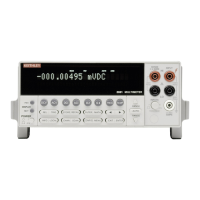IEEE-488 Reference
4-117
Query
:FUNCtion? Query currently programmed function.
Short-form format: :func?
Response messages: Function name
Description
The :FUNCtion command is used to select the measurement function of the instrument. Note
that parameter names are enclosed in single quotes (‘). However, double quotes (“) can instead
be used. For example:
:func ‘volt:dc’ = :func “volt:dc”
Each measurement function “remembers” its own unique setup configuration, such as range,
speed, resolution, filter and rel. This eliminates the need to re-program setup conditions every
time you switch from one function to another.
Programming example
10 OUTPUT 716; “:func ‘volt:ac’; func?”
20 ENTER 716; A$
30 PRINT A$
40 END
Line 10 Two commands in this program message, the first command selects ACV, and second
command queries the function.
Line 20 Addresses the Model 2001 to talk.
Line 30 Displays (on CRT) the function name (VOLTS:AC).
4.19.4
DATA Commands
[:LATest]?
[:SENSe[1]]:DATA[LATest]? Request latest reading.
Description
This query command is used to read the latest instrument reading. This command returns the
“raw” reading or a reading that is the result of the Reference (REL from the front panel) opera-
tion. For example, if a reference value of 1.0 is established, the reading returned by this com-
mand is the “raw” reading minus 1.0. Calculated (MATH) readings cannot be read with this
command (see the CALCulate Subsystem to read math calculations).
The reading is returned in exponent form. For example, a 10V DC reading is displayed on the
CRT as follows:
+1.000000E+01
Notice that the measurement function is not included in the response message. Thus, you may
want to perform a function query (see previous command) after a reading query.
Programming example
10 OUTPUT 716; “:data?; func?”
20 ENTER 716; A$
30 PRINT A$
40 END
Line 10 Requests latest reading and queries function.
Line 20 Addresses 2001 to talk.
Line 30 Displays the reading and function.

